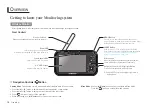
PN 15037:D2 9/9/02
3
Installation Precautions
Adherence to the following will aid in problem-free installation with long-term reliability:
WARNING - Several different sources of power can
be connected to the fire alarm control panel.
Discon-
nect all sources of power before servicing. Control unit
and associated equipment may be damaged by remov-
ing and/or inserting cards, modules, or interconnecting
cables while the unit is energized. Do not attempt to
install, service, or operate this unit until this manual is
read and understood.
CAUTION - System Reaccepting Test after Software
Changes.
To ensure proper system operation, this
product must be tested in accordance with NFPA 72
Chapter 7 after any programming operation or change in
site-specific software. Reaccepting testing is required
after any change, addition or deletion of system compo-
nents, or after any modification, repair or adjustment to
system hardware or wiring.
All components, circuits, system operations, or software
functions known to be affected by a change must be
100% tested. In addition, to ensure that other operations
are not inadvertently affected, at least 10% of initiating
devices that are not directly affected by the change, up
to a maximum of 50 devices, must also be tested and
proper system operation verified.
This system
meets NFPA requirements for operation at
0-49° C/32-120° F and at a relative humidity of 85% RH
- 93% per ULC - (non-condensing) at 30° C/86° F. How-
ever, the useful life of the system's standby batteries
and the electronic components may be adversely
affected by extreme temperature ranges and humidity.
Therefore, it is recommended that this system and all
peripherals be installed in an environment with a nomi-
nal room temperature of 15-27° C/60-80° F.
Verify that wire sizes are adequate
for all initiating and
indicating device loops. Most devices cannot tolerate
more than a 10% I.R. drop from the specified device
voltage.
Like all solid state electronic devices,
this system
may operate erratically or can be damaged when sub-
jected to lightning-induced transients. Although no sys-
tem is completely immune from lightning transients and
interferences, proper grounding will reduce susceptibil-
ity. Overhead or outside aerial wiring is not recom-
mended, due to an increased susceptibility to nearby
lightning strikes. Consult with the Technical Services
Department if any problems are anticipated or encoun-
tered.
Disconnect AC power and batteries
prior to removing
or inserting circuit boards. Failure to do so can damage
circuits.
Remove all electronic assemblies
prior to any drilling,
filing, reaming, or punching of the enclosure. When pos-
sible, make all cable entries from the sides or rear.
Before making modifications, verify that they will not
interfere with battery, transformer, and printed circuit
board location.
Do not tighten screw terminals
more than 9 in-labs.
Overtightening may damage threads, resulting in
reduced terminal contact pressure and difficulty with
screw terminal removal.
Though designed to last many years,
system compo-
nents can fail at any time. This system contains static-
sensitive components. Always ground yourself with a
proper wrist strap before handling any circuits so that
static charges are removed from the body. Use static-
suppressive packaging to protect electronic assemblies
removed from the unit.
Follow the instructions
in the installation, operating,
and programming manuals. These instructions must be
followed to avoid damage to the control panel and asso-
ciated equipment. FACP operation and reliability
depend upon proper installation by authorized person-
nel.
Precau-S-4-2002.fm
FCC Warning
WARNING:
This equipment generates, uses, and
can radiate radio frequency energy and if not
installed and used in accordance with the instruction
manual, may cause interference to radio communi-
cations. It has been tested and found to comply with
the limits for class A computing device pursuant to
Subpart B of Part 15 of FCC Rules, which is
designed to provide reasonable protection against
such interference when operated in a commercial
environment. Operation of this equipment in a resi-
dential area is likely to cause interference, in which
case the user will be required to correct the interfer-
ence at his own expense.
Canadian Requirements
This digital apparatus does not exceed the Class A
limits for radiation noise emissions from digital appa-
ratus set out in the Radio Interference Regulations of
the Canadian Department of Communications.
Le present appareil numerique n'emet pas de bruits
radioelectriques depassant les limites applicables
aux appareils numeriques de la classe A prescrites
dans le Reglement sur le brouillage radioelectrique
edicte par le ministere des Communications du
Canada.
Acclimate Plus™, HARSH™, NOTI•FIRE•NET™, ONYX™, and VeriFire™ are trademarks, and FlashScan® and
VIEW® are registered trademarks of NOTIFIER. NION™ and UniNet™ are trademarks of NIS. NIS™ and Notifier
Integrated Systems™ are trademarks and NOTIFIER® is a registered trademark of Fire•Lite Alarms, Inc. Echelon®
is a registered trademark and LonWorks™ is a trademark of Echelon Corporation. ARCNET® is a registered trade-
mark of Datapoint Corporation. Microsoft® and Windows® are registered trademarks of the Microsoft Corporation.
LEXAN® is a registered trademark of GE Plastics, a subsidiary of General Electric Company.
Содержание LCD-80
Страница 1: ...PN 15037 D2 ECN 02 339 Liquid Crystal Display LCD 80 Installation Manual Document 15037 9 9 02 Rev D2...
Страница 4: ...4 PN 15037 D2 9 9 02 Notes...
Страница 6: ...6 PN 15037 D2 9 9 02 Notes...
Страница 10: ...10 PN 15037 D2 9 9 02 Notes...
Страница 49: ...PN 15037 D2 9 9 02 49 Notes...
Страница 50: ...50 PN 15037 D2 9 9 02 Notes...




































